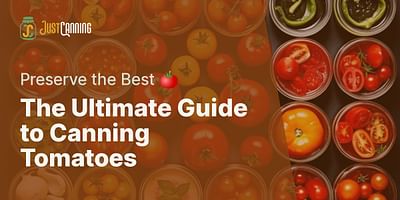Tom Bennett is a DIY enthusiast who loves to build and modify canning equipment. He enjoys writing about his projects and teaching others how to make their own canning tools.
When it comes to home canning, ensuring the longevity and safety of your food begins with sterilizing your canning jars. This crucial step eliminates any bacteria, yeast, or fungi that could spoil your canned goods. But what if you don't have a canner? Don't worry! I'm here to share some DIY canning techniques that will help you sterilize your jars without one.
First off, did you know your oven can double as a sterilizer? It's true! With a bit of care to avoid thermal shock, the oven method is a viable option. Then there's the dishwasher method, which combines convenience with efficiency. And let's not forget the good old boiling water method, an accessible and simple solution for canning jars sterilization.
Whether you're preparing canning tomato recipes, canning pumpkins recipes, or even a canning pepperoncinis recipe, these methods will ensure your jars are ready and safe. And if you're wondering about canning lids reuse, we'll cover that too. So, ready to dive into the world of canning without a canner? Let's get started!
🔥 Let's Heat Things Up: Sterilizing Canning Jars in the Oven
Now, let's dive into the oven method, a handy DIY canning technique for sterilizing your jars. It's simple, but caution is key to avoid thermal shock, which can cause your jars to crack or break.
Start by preheating your oven to 225°F (107°C). While it's heating up, wash your canning jars and lids thoroughly with warm, soapy water. Rinse them well to remove any soap residue.
Next, arrange your jars and lids evenly spaced on a baking sheet. Once the oven is preheated, place the baking sheet in the oven and let them sterilize for at least 20 minutes.
Remember, safety first! Use oven mitts when handling the hot jars and lids. Allow the jars to cool down in the oven before removing them. This cool down period is crucial to prevent thermal shock.
So, can you sterilize canning jars without a canner? Absolutely! With these home canning tips, you're well on your way to preserving your favorite canning recipes, be it canning tomatoes, pumpkins, pepperoncinis, or pickle beets. Happy canning!
💦 Dishwasher Magic: Easy Canning Jar Sterilization at Home
Now, let's dive into the dishwasher method, a convenient alternative for canning jars sterilization. Who doesn't love a hands-off approach? With this method, you can sterilize your jars while you prepare your canning recipes. It's a great way to multitask and save time.
Start by placing your canning jars, lids, and rings in the dishwasher. Ensure they are evenly spaced and not clumped together. This will allow the hot water and steam to circulate properly, ensuring thorough sterilization. For best results, use the 'sanitize' cycle if your dishwasher has one. This setting uses extra-hot water and a longer wash cycle to kill bacteria and other microorganisms. If your dishwasher doesn't have a 'sanitize' cycle, don't worry. Just choose the longest cycle with the hottest water.
Remember, the goal here is to ensure that your jars are free from any harmful bacteria that could spoil your canned goods. So, it's crucial to keep the jars in the dishwasher until you're ready to use them. This will prevent them from getting contaminated after they've been sterilized. Now, isn't this a breeze?
🌊 Dive into Simplicity: Sterilize Your Canning Jars with Boiling Water
Now, let's talk about the Boiling Water Method, a classic technique in canning jars sterilization that's as accessible as your kitchen faucet. Who said you need fancy equipment for effective home canning? In fact, you can even make quality pickles without using a canner.
First, place your canning jars in a large pot, ensuring they're fully submerged in water. Bring the water to a boil and let it bubble away for at least 10 minutes. For those at higher altitudes, add an extra minute for every 1000 feet above sea level. This is because water boils at lower temperatures at higher altitudes, and we need to ensure those jars are squeaky clean!
Once the time is up, use tongs to carefully remove the jars, placing them upside down on a clean towel to dry. And voila! Your jars are now ready to be filled with delicious canning recipes, be it canning tomatoes, pumpkins, or even those spicy pepperoncinis! If you're looking for inspiration, check out our guide on canning plums or learn how to can baked beans at home.
Remember, the beauty of this method lies in its simplicity. No need for a canner or complex procedures. Just you, your pot, and the power of boiling water. But if you're wondering about the specifics of the canning process, you can learn more about how the process of canning functions. So, ready to give it a try?
For a visual guide on how to sterilize your canning jars without a canner, check out the video below. It demonstrates the three methods we've discussed in this article.
Now that you've seen these sterilizing methods in action, you can choose the one that best suits your needs and resources. Remember, the important thing is to ensure your jars are properly sterilized before you start canning to ensure food safety and longevity.
As we wrap up, let's remember that the heart of successful home canning lies in the sterilization of your canning jars. Whether you prefer the oven method, the convenience of the dishwasher, or the simplicity of boiling water, the choice is yours. What matters most is that your chosen method aligns with your needs and resources, and most importantly, that it effectively sterilizes your jars for safe and long-lasting food preservation. If you're looking for the perfect canning pot to assist you in this process, check out our guide on choosing the best canning pot with a rack for your kitchen.
So, are you ready to dive into the world of DIY canning techniques? Exciting, isn't it? With these sterilization methods, you can now confidently can without a canner. And don't forget, the adventure doesn't stop here. Explore our steam canning guide, delve into the debate on reusing canning lids, or whip up some of our delicious canning recipes. How about a tangy tomato recipe or a sweet pumpkin one? Or perhaps a spicy pepperoncinis or a tangy pickle beets recipe? The possibilities are endless!
Remember, the joy of canning is not just about preserving food, but also about the satisfaction of creating something homemade and delicious. So, let's get those jars sterilized and start canning!




![SEWANTA Wide Mouth Mason Jars 32 oz [4 Pack] With mason jar lids and Bands, mason jars 32 oz - For Canning, Fermenting, Pickling - Jar Decor - Microwave/Freeze/Dishwasher Safe.](https://m.media-amazon.com/images/I/81O6XmQwSqL._AC_SX444_SY639_QL65_.jpg)



![SEWANTA Wide Mouth Mason Jars 16 oz [5 Pack] With mason jar lids and Bands, mason jars 16 oz - For Canning, Fermenting, Pickling - Jar Décor - Microwave/Freeze/Dishwasher Safe](https://m.media-amazon.com/images/I/91pcfxG3dtL._AC_SX444_SY639_QL65_.jpg)







![[6 Pack] 16 oz. Regular-Mouth Glass Mason Jars with Metal Airtight Lids and Bands for 1 Pint Canning, Preserving, & Meal Prep](https://m.media-amazon.com/images/I/71mCH-Kt6QL._AC_SX444_SY639_QL65_.jpg)













